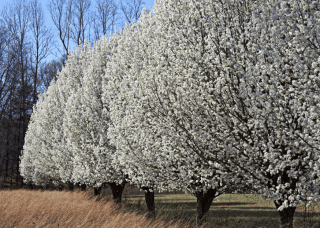Bradford Pear trees are a popular choice for homeowners due to their beautiful white blossoms in the spring and vibrant foliage in the fall. However, like any other tree, Bradford Pears require regular maintenance to stay healthy and attractive. One essential aspect of caring for these trees is trimming. This article will explore the importance of trimming Bradford Pear trees, its benefits, when and how to trim them, common mistakes to avoid, and proper care after trimming.
Why trimming Bradford Pear Trees is important
Regular trimming is crucial for maintaining the health and beauty of Bradford Pear trees. Trimming helps to improve their overall structure, promotes new growth, and prevents diseases and pests from infesting the tree.
Benefits of trimming Bradford Pear Trees
- Improving tree structure: Bradford Pear trees may develop weak or crossing branches over time. Trimming helps eliminate these structural issues, reducing the risk of branch breakage during storms and improving the tree's stability.
- Promoting new growth: Trimming stimulates the growth of new branches and leaves. It allows more sunlight and air circulation through the canopy, encouraging the tree to produce denser foliage and blossom more abundantly.
- Preventing disease and pests: Trimming removes dead or diseased branches, preventing the spread of infections or infestations. It also enhances the tree's overall health, making it more resistant to common pests and diseases.
When to trim Bradford Pear Trees
The best time to trim Bradford Pear trees is during their dormant season, typically in late winter or early spring. During this time, the tree is less vulnerable to diseases and pests. It has a better chance of healing quickly after trimming. However, if you notice any signs of dead or damaged branches, it's important to address them promptly, regardless of the season.
How to trim Bradford Pear Trees
Trimming Bradford Pear trees requires proper techniques to ensure optimal health and beauty.
Here is a step-by-step guide to help you:
- Gather the necessary tools: Before starting, gather essential tools such as pruning shears, loppers, and saws. Ensure that your tools are clean and sharp for efficient and clean cuts.
- Shape the tree: Begin by shaping the tree's overall structure. Remove any branches that cross or rub against each other and any dead or diseased branches. Focus on maintaining a balanced and open canopy.
- Remove dead branches: Identify and remove dead branches throughout the tree. Deadwood not only looks unsightly but can also attract pests and diseases.
- Control growth: Trim back any excessively long or fast-growing branches to control the tree's size and shape. Avoid cutting off more than 25% of the tree's foliage in a single trimming session to prevent stress.
Common mistakes to avoid when trimming Bradford Pear Trees
While trimming is essential, some common mistakes should be avoided to prevent harm to your Bradford Pear tree.
- Over-trimming Bradford Pear Trees: Over-trimming, also known as a topping, harms the tree's health. It weakens the structure and can lead to the growth of weak, unstable branches. Avoid removing more than necessary and aim to maintain a natural and balanced shape.
- Using incorrect pruning techniques: Improper pruning techniques, such as topping, heading, and stub cuts, can damage the tree and hinder its growth. Always make clean cuts just above the branch collar, the swollen area at the branch's base, to promote quick healing and minimize the risk of infection.
How to care for Bradford Pear Trees after trimming
Proper care after trimming is crucial for the tree's recovery and continued health.
- Watering and fertilizing Bradford Pear Trees: After trimming, monitor the tree's moisture levels and water it deeply and infrequently, allowing the soil to dry out slightly between waterings. Apply a slow-release fertilizer in early spring to provide essential nutrients for new growth.
- Monitoring for pests and disease: Regularly inspect your Bradford Pear tree for signs of pests or diseases, such as leaf discoloration, wilting, or abnormal growth. If any issues are detected, consult an arborist or horticulturist for proper diagnosis and treatment options.
Conclusion
Trimming Bradford Pear trees is vital for maintaining their health, structure, and beauty. Following the proper techniques and avoiding common mistakes can ensure the tree's well-being and enhance its overall appearance. Ensure adequate care after trimming, including proper watering, fertilization, and monitoring for pests and diseases. If you need clarification on trimming or have a large or complex tree, it's always advisable to hire a professional arborist.
Final tips for Bradford Pear Tree trimming
When trimming Bradford Pear trees, it's essential to prioritize safety. Wear appropriate protective gear, such as gloves, safety glasses, and a hard hat, to prevent injuries. If you need more confidence in your trimming skills or dealing with a large tree, consider hiring an ISA-Certified Arborist for expert guidance. Lastly, maintain a consistent trimming schedule to ensure the tree's ongoing health and beauty.
For professional tree services in Delaware, Pennsylvania, Maryland, and Southern New Jersey, contact Strobert Tree Services. Our team of ISA-Certified Arborists can assist you with all your tree care needs.











